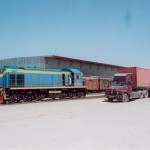Exciting news from the Asian Development Bank today. Uzbekistan’s national railway UTY is to be awarded contracts to build a 75 km line from the Hayratan freight terminal to Mazar-i-Sharif by June 2011.
ADB is providing a USD165m grant towards the USD170m cost, with the Afghan government paying the remaining USD5m. Normal tendering procedures are being relaxed as UTY is the only organisation in a position to build and operate the line. As it will be in effect an extension of the Uzbek rail network, the line will be to 1520 mm gauge.
“Security remains an ongoing concern”, but “the project area is deemed relatively safe”.
ADB-Funded Railway to Help Afghanistan Improve Regional Links, Boost Growth
30 September 2009
MANILA, PHILIPPINES – Afghanistan’s push to develop reliable, safer, sustainable transport systems that boost growth, and increase connectivity with neighboring countries are getting support from a $165 million Asian Development Bank (ADB) grant.
The funds will be used to build a 75 kilometer single line railway between Hairatan – a northern town at the border with Uzbekistan that is the gateway for almost half of Afghanistan’s imports and much of its humanitarian relief goods – and Mazar-e-Sharif, the second largest city in the country. The project will also upgrade Hairatan station yard, build a transshipment terminal and provide institutional support to develop a railway sector plan.
Afghanistan has the potential to play a key role as a transit route in Central Asia for goods going to ports in Pakistan and the Caspian, and onwards to South and East Asia, the Middle East and Europe. However, trade volumes are heavily constrained by weak transport systems. In the case of Hairatan, freight railed from inside Uzbekistan stops at the border and then has to be offloaded and reloaded into trucks, causing delays and raising costs.
“This line will boost freight volumes, lower costs, raise the profile of Afghanistan as a transit route, and complement two major transport corridors being developed under the Central Asia Regional Cooperation Program (CAREC),” said Balabhaskara Reddy Bathula, Transport Specialist with ADB’s Central and West Asia Department. The project is the first phase of a larger rail network planned for the country, including links to Herat, Tajikistan and Pakistan and is part of CAREC’s broad push to improve connectivity throughout the region, supporting growth and cutting poverty.
Security remains an ongoing concern in Afghanistan and while the project area is deemed relatively safe, the Government has pledged to provide all necessary security support. The project will also bring environmental benefits with double-stack containers helping increase fuel efficiency.
To overcome past problems linked to transport projects, such as cost overruns and delays, the Government will be entering into direct contracts with Uzbekistan Railways Company, both for the engineering, procurement and construction of the new facilities, and for their operation and maintenance. The decision to relax normal procurement procedures is justified by the fact that the new railway will be a de-facto extension of the company’s current line from Termez in Uzbekistan to Hairatan; it does not require investments in new rolling stock; there are no comparable companies in the region capable of designing, building, operating and maintaining a line based on the Uzbekistan system; and the company has proprietary preliminary designs, which accelerates project readiness, saving considerable time and costs.
ADB’s grant covers 97% of the total project cost of $170 million, with the Government contributing $5 million. The Ministry of Public Works will be the executing agency, with June 2011 the estimated completion date.
Source: Asian Development Bank, 2009-09-30

